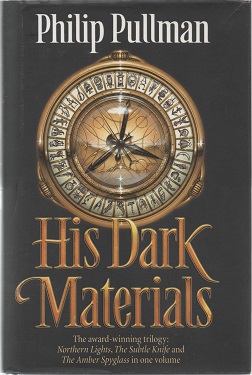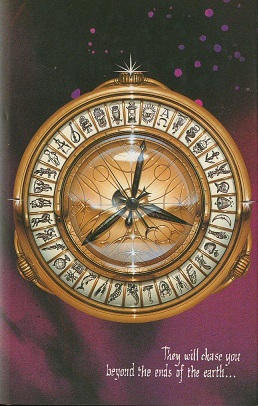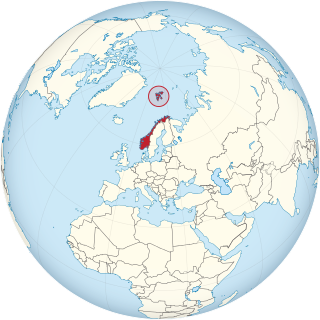
Svalbard, previously known as Spitsbergen or Spitzbergen, is a Norwegian archipelago in the Arctic Ocean. North of mainland Europe, it lies about midway between the northern coast of Norway and the North Pole. The islands of the group range from 74° to 81° north latitude, and from 10° to 35° east longitude. The largest island is Spitsbergen, followed in size by Nordaustlandet and Edgeøya. The largest settlement is Longyearbyen on the west coast of Spitsbergen.

His Dark Materials is a trilogy of fantasy novels by Philip Pullman consisting of Northern Lights, The Subtle Knife (1997), and The Amber Spyglass (2000). It follows the coming of age of two children, Lyra Belacqua and Will Parry, as they wander through a series of parallel universes. The novels have won a number of awards, including the Carnegie Medal in 1995 for Northern Lights and the 2001 Whitbread Book of the Year for The Amber Spyglass. In 2003, the trilogy was ranked third on the BBC's The Big Read poll.

Spitsbergen, is the largest and the only permanently populated island of the Svalbard archipelago in northern Norway.

Bear Island is the southernmost island of the Norwegian Svalbard archipelago. The island is located at the limits of the Norwegian and Barents Seas, approximately halfway between Spitsbergen and the North Cape. Bear Island was discovered by Dutch explorers Willem Barentsz and Jacob van Heemskerck on 10 June 1596. It was named after a polar bear that was seen swimming nearby. The island was considered terra nullius until the Spitsbergen Treaty of 1920 placed it under Norwegian sovereignty.

Longyearbyen is the world's northernmost settlement with a population greater than 1,000, and the largest inhabited area of Svalbard, Norway. It stretches along the foot of the left bank of the Longyear Valley and on the shore of Adventfjorden, the short estuary leading into Isfjorden on the west coast of Spitsbergen, the island's broadest inlet. As of 2002 Longyearbyen Community Council became an official Norwegian municipality. It is the seat of the Governor of Svalbard. The town's mayor is Arild Olsen.
Barentsburg is the second-largest settlement in Svalbard, Norway, with about 455 inhabitants (2020). A coal mining town, the settlement was almost entirely made up of ethnic Russians and Ukrainians. With the 2022 Russian invasion of Ukraine, most of the Ukrainian citizens were reported to have left.

Fram ("Forward") is a ship that was used in expeditions of the Arctic and Antarctic regions by the Norwegian explorers Fridtjof Nansen, Otto Sverdrup, Oscar Wisting, and Roald Amundsen between 1893 and 1912. It was designed and built by the Scottish-Norwegian shipwright Colin Archer for Fridtjof Nansen's 1893 Arctic expedition in which the plan was to freeze Fram into the Arctic ice sheet and float with it over the North Pole.

Northern Lights is a young-adult fantasy novel by Philip Pullman, published in 1995 by Scholastic UK. Set in a parallel universe, it follows the journey of Lyra Belacqua to the Arctic in search of her missing friend, Roger Parslow, and her imprisoned uncle, Lord Asriel, who has been conducting experiments with a mysterious substance known as "Dust".

Edgeøya, anglicised as Edge Island, is a Norwegian island located in southeast of the Svalbard archipelago; with an area of 5,073 square kilometres (1,960 sq mi), it is the third-largest island in this archipelago. An Arctic island, it forms part of the Søraust-Svalbard Nature Reserve, home to polar bears and reindeer. An ice field covers its eastern side. The island takes its name from Thomas Edge, an English merchant and whaler. It is seldom visited today and development of tourist facilities is forbidden by law because of its nature reserve status.

The Svalbard Global Seed Vault is a secure backup facility for the world's crop diversity on the Norwegian island of Spitsbergen in the remote Arctic Svalbard archipelago. The Seed Vault provides long-term storage of duplicates of seeds conserved in genebanks around the world. This provides security of the world's food supply against the loss of seeds in genebanks due to mismanagement, accident, equipment failures, funding cuts, war, sabotage, disease and natural disasters. The Seed Vault is managed under terms spelled out in a tripartite agreement among the Norwegian government, the Crop Trust, and the Nordic Genetic Resource Center (NordGen).

Andrée's Arctic balloon expedition of 1897 was a failed Swedish effort to reach the North Pole, resulting in the deaths of all three expedition members, S. A. Andrée, Knut Frænkel, and Nils Strindberg. Andrée, the first Swedish balloonist, proposed a voyage by hydrogen balloon from Svalbard to either Russia or Canada, which was to pass, with luck, straight over the North Pole on the way. The scheme was received with patriotic enthusiasm in Sweden, a northern nation that had fallen behind in the race for the North Pole.

Rossøya, sometimes referred to as Ross Island in English, is an island located in the Arctic Ocean. It is a part of Sjuøyane, a group of islands in the Svalbard archipelago, some 20 km north of the coast of Nordaustlandet, Svalbard in Arctic Norway. Rossøya is located 100 m north-northwest of the somewhat larger island Vesle Tavleøya. The northern point of Rossøya, at 80° 49′ 44.41″ North, is the northernmost point in Svalbard, and thereby also in the Kingdom of Norway. The distance to the North Pole is 1024.3 kilometers, to Nordkapp on the Norwegian mainland 1084 km and to Pysen, off the southern tip of mainland Norway, 2580 km.
His Dark Materials is a trilogy of fantasy novels by Philip Pullman consisting of Northern Lights (1995), The Subtle Knife (1997), and The Amber Spyglass (2000). This is a list of the fictional races and creatures in the novels.
This article covers the fictional locations in the His Dark Materialstrilogy and related works by Philip Pullman.

Operation Haudegen was the name of a German operation during the Second World War to establish meteorological stations on the Svalbard archipelago in Norway. In September 1944, the submarine U-307 and the supply ship Carl J. Busch transported the men of Unternehmen Haudegen to the island. The station was active from 9 September 1944. On May 8, 1945, the staff received a message from their commanders in Tromsø that Germany had surrendered and the war was over. After that, radio contact was lost. The soldiers were capable of asking for support only in August 1945 and on 6 September, were picked up by a Norwegian seal hunting vessel and surrendered to its captain. The group of men were the last German troops to surrender after the Second World War.

Svalbard is a Norwegian archipelago in the Arctic Ocean. The climate of Svalbard is principally a result of its latitude, which is between 74° and 81° north. Climate is defined by the World Meteorological Organization as the average weather over a 30-year period. The North Atlantic Current moderates Svalbard's temperatures, particularly during winter, giving it up to 20 °C (36 °F) higher winter temperature than similar latitudes in continental Russia and Canada. This keeps the surrounding waters open and navigable most of the year. The interior fjord areas and valleys, sheltered by the mountains, have fewer temperature differences than the coast, with about 2 °C lower summer temperatures and 3 °C higher winter temperatures. On the south of the largest island, Spitsbergen, the temperature is slightly higher than further north and west. During winter, the temperature difference between south and north is typically 5 °C, and about 3 °C in summer. Bear Island (Bjørnøya) has average temperatures even higher than the rest of the archipelago.

Operation Fritham was an Allied military operation during the Second World War to secure the coal mines on Spitsbergen, the main island of the Svalbard Archipelago, 650 mi (1,050 km) from the North Pole and about the same distance from Norway. The operation was intended to deny the islands to Nazi Germany.
Svalbard is an Arctic, wilderness archipelago comprising the northernmost part of Norway. It is mostly uninhabited, with only about 3,000 people, yet covers an area of 61,020 square kilometres (23,560 sq mi).

Antarctic was a Swedish steamship built in Drammen, Norway, in 1871. She was used on several research expeditions to the Arctic region and to Antarctica from 1898 to 1903. In 1895 the first confirmed landing on the mainland of Antarctica was made from this ship.

Operation Gearbox was a joint Norwegian and British operation to occupy the Arctic island of Spitsbergen during the Second World War. It superseded Operation Fritham, an expedition in May, to secure the coal mines on Spitsbergen, the main island of the Svalbard Archipelago which had failed when attacked by four German Focke-Wulf Fw 200 Condor reconnaissance bombers. The Norwegian force, with 116 long tons (118 t) of supplies, arrived by British cruiser on 2 July.















